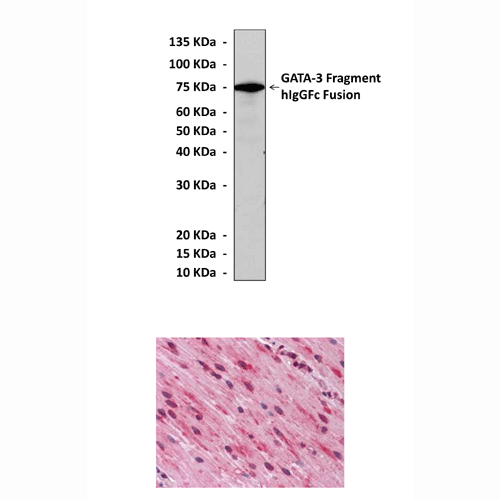Product Sheet CP10307
Description
BACKGROUND The family of GATA transcription factors consists of six proteins (GATA-1–6). GATA-1–2–3 are important regulators of hematopoietic stem cells and their derivatives, whereas GATA-4, -5, and -6 genes are expressed in various mesoderm and endoderm-derived tissues. They have been found to play important roles in multiple stages of mammalian life, beginning with early development, continuing during organogenesis, and finally in homeostasis in the adult and involved in the development of many organ systems, including those for hematopoietic, cardiovascular, reproductive, and gut-endoderm derived tissues.1 A characteristic feature of GATA factors is a domain of two adjacent zinc fingers (Cys-X2-Cys-X17-Cys-X2-Cys) that directs preferential binding to the nucleotide sequence element 5′-(A/T)GATA(A/G)-3′ of target gene promoters.
As a member of the GATA family of zinc finger transcription factors, GATA-3 plays key roles in controlling cell fate decisions, in particular, in different hematopoietic lineages. Early in lymphoid development, GATA-3 is essential for the T lymphoid cell lineage, whereas later, it is critical for differentiation of naive CD4+ T cells into Th2 as opposed to Th1 effector cells. The GATA-3 knock-out mouse has significant developmental abnormalities and is embryonically lethal. Recently, conditional knock-out of GATA-3 revealed a crucial role for this factor at multiple stages of mammary gland development, including the formation of terminal end buds at puberty and luminal cell differentiation. This is reminiscent to the phenotype of ERα knock-out mice. These observations could explain why GATA-3 and ERα-positive breast tumors tend to be morphologically more differentiated and less aggressive than hormone-independent tumors. Gata-3 is a defining marker of the \'luminal\' subtypes of breast cancer.2 In addition GATA-3 shows a specific and restricted expression pattern in the developing and adult mouse brain. It was demonstrated that GATA-3 plays a major role in the development of the serotonergic neurons of the caudal raphe nuclei, and that it is crucial for their role in locomotion.3 Moreover, it was shown that GATA-3 is involved in axonal navigation of the inner ear efferent neurons and, simultaneously, in the morphogenesis of the inner ear.4
As a member of the GATA family of zinc finger transcription factors, GATA-3 plays key roles in controlling cell fate decisions, in particular, in different hematopoietic lineages. Early in lymphoid development, GATA-3 is essential for the T lymphoid cell lineage, whereas later, it is critical for differentiation of naive CD4+ T cells into Th2 as opposed to Th1 effector cells. The GATA-3 knock-out mouse has significant developmental abnormalities and is embryonically lethal. Recently, conditional knock-out of GATA-3 revealed a crucial role for this factor at multiple stages of mammary gland development, including the formation of terminal end buds at puberty and luminal cell differentiation. This is reminiscent to the phenotype of ERα knock-out mice. These observations could explain why GATA-3 and ERα-positive breast tumors tend to be morphologically more differentiated and less aggressive than hormone-independent tumors. Gata-3 is a defining marker of the \'luminal\' subtypes of breast cancer.2 In addition GATA-3 shows a specific and restricted expression pattern in the developing and adult mouse brain. It was demonstrated that GATA-3 plays a major role in the development of the serotonergic neurons of the caudal raphe nuclei, and that it is crucial for their role in locomotion.3 Moreover, it was shown that GATA-3 is involved in axonal navigation of the inner ear efferent neurons and, simultaneously, in the morphogenesis of the inner ear.4
REFERENCES
1. Pikkarainen, S. et al: Cardiovascul. Res. 63:196-207, 2004
2. Asselin-Labat, M.L. et al: Nature Cell Biol. 9:201-9, 2007
3. van Doorninck, J.H. et al: J. Neurosci. 0:RC12:1-8, 1999
4. Karis, A. et al: J. Comp. Neurol. 429:615–30, 2001
2. Asselin-Labat, M.L. et al: Nature Cell Biol. 9:201-9, 2007
3. van Doorninck, J.H. et al: J. Neurosci. 0:RC12:1-8, 1999
4. Karis, A. et al: J. Comp. Neurol. 429:615–30, 2001
Products are for research use only. They are not intended for human, animal, or diagnostic applications.
Details
Cat.No.: | CP10307 |
Antigen: | Raised against recombinant human GATA-3 fragments expressed in E. coli. |
Isotype: | Mouse IgG1 |
Species & predicted species cross- reactivity ( ): | Human |
Applications & Suggested starting dilutions:* | WB 1:1000 IP n/d IHC n/d ICC n/d FACS n/d |
Predicted Molecular Weight of protein: | 48 kDa |
Specificity/Sensitivity: | Detects endogenous GATA-3 proteins without cross-reactivity with other family members. |
Storage: | Store at -20°C, 4°C for frequent use. Avoid repeated freeze-thaw cycles. |
*Optimal working dilutions must be determined by end user.
Products
| Product | Size | CAT.# | Price | Quantity |
|---|---|---|---|---|
| Mouse GATA-3 Antibody: Mouse GATA-3 Antibody | Size: 100 ul | CAT.#: CP10307 | Price: $413.00 |

